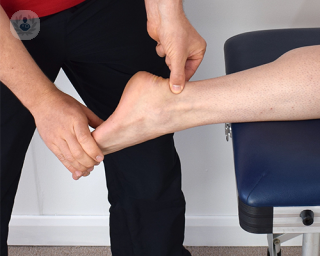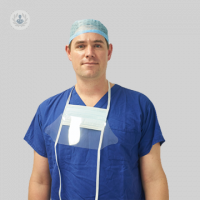Ankle replacement surgery
Mr Raj Kumar - Orthopaedic surgery
Created on: 04-26-2017
Updated on: 09-26-2023
Edited by: Jay Staniland
What is ankle replacement surgery?
Ankle replacement surgery involves a total replacement of the ankle joint that connects the tibia (shin) to the talus (ankle bone). The natural joint is replaced with a prosthetic joint to restore foot mobility and reduce pain. The surgery is performed by an orthopaedic surgeon specialised in foot and ankle surgery.
There is a wide range of prosthetic ankle joints available and prosthetic technology has advanced significantly in the past 30 years.

Why is ankle replacement surgery needed?
Ankle replacement surgery is typically performed on patients whose ankle joint has been severely affected by osteoarthritis. Generally, it is recommended as an option when other approaches, such as pain medication, shoe inserts or physical therapy, haven’t worked to control symptoms of pain and discomfort.
The main reasons patients undergo this surgery are due to:
- osteoarthritis
- infection
- rheumatoid arthritis
- bone fracture
Most patients that undergo this procedure are over the age of 60, but it is sometimes offered to younger patients depending on their condition.
What does ankle replacement surgery consist of?
The procedure consists of making a 15cm long incision over the front of the ankle and then cutting away or removing the damaged bone and joint. They will then insert a new artificial joint and connect it to the newly cut down bone. The surgeon puts the tendons and muscles back into place and sews up the incision. The entire operation can last up to an hour and a half.
Ankle replacement surgery is usually performed under general anaesthesia but in some cases, a local anaesthetic may be used so that you can eat and drink immediately afterwards and leave the hospital sooner.
How to prepare for surgery
Patients will have a checkup a few weeks before the procedure to make sure they are healthy enough to undergo surgery. A physical therapist may also check to see how well the ankle joint works, to compare following surgery.
Patients may be asked to stop taking certain medications such as blood thinners, a few days before the procedure.
On the day of the procedure, patients will first meet with an anaesthetist to review the anaesthesia options or other types of sedatives.
After the surgery
Following surgery, patients will likely spend up to three days in hospital, with the leg elevated until the swelling subsides. Once the swelling is reduced, a cast will be placed on the leg and training will be provided to learn how to walk using crutches.
Depending on the hospital and recovery rate, the ankle may be in a cast for 3-6 weeks. During this time, patients will have a number of checkups with a nurse, who will remove the cast, inspect the incision wounds and apply a new cast.
After a few weeks, patients will have an X-ray to check the ankle, and if it has completely healed. Once the doctor is confident that the ankle has healed corrected, the cast will be removed and patients will go through some rehabilitation exercises. You will continue to receive continuous physiotherapy following surgery to help mobilise the ankle.
Recovery from ankle replacement surgery
During the first few days, patients may experience some moderate pain but this can be controlled with appropriate pain-relieving medication.
During the first two weeks after the operation, weight must not be applied to the foot. Time off work may be required, and driving won't be permitted until an emergency stop can be performed without experiencing pain in the foot.
Once the cast is removed patients can begin to increase the level of exercise; walking and swimming are the best during the recovery period. Thedoctor will likely advise not to participate in high impact sports such as rugby or tennis.
Alternative treatments to ankle replacement surgery
Ankle surgery is not recommended in patients with:
- a collapsed talus (ankle bone)
- loss of sensation in the feet due to diabetes
- poor circulation in the legs
- severe ankle deformity
- ligament instability
In these cases, an ankle fusion might be recommended instead.
If you would like to be considered for ankle replacement surgery, and would like to book a consultation with a specialist, you can do so on the Top Doctors page.

















